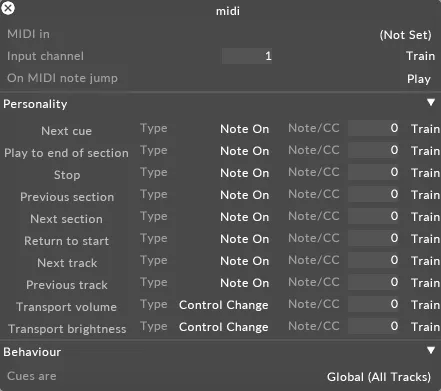Setup MIDI Note
Designer can respond to MIDI notes in several ways. You can use MIDI notes to select different tracks, trigger transport commands (play, stop, next/previous section, etc) or to jump to particular sections.
Creating a EventTransportMIDI Object
Section titled “Creating a EventTransportMIDI Object”- Right-click the transport button from the dashboard.
- Click the + icon under the Events Transport section and create a new Event TransportMIDI object. The EventTransportMIDI editor will open.
- Make sure to press the engage button to enable the MIDI note input.

EventTransportMIDI Editor
Section titled “EventTransportMIDI Editor”
MIDI Device
Section titled “MIDI Device”The MIDI device to use. You may need to download and install the driver for the MIDI device. Make sure that no other MIDI utilities such as MIDIOX are open while inputting to d3 as they may conflict with d3.
Input Channel (1 - 16)
Section titled “Input Channel (1 - 16)”Which MIDI channel to listen on.
Next-Cue
Section titled “Next-Cue”The MIDI note, in decimal, to use to jump to the next cue.
Play to End of Section
Section titled “Play to End of Section”The MIDI note, in decimal, to use to set the play mode to play to end of section.
The MIDI note, in decimal, to use to set the play mode to stop.
The MIDI note, in decimal, to use to jump to the previous section.
The MIDI note, in decimal, to use to jump to the next secton.
Return to Start
Section titled “Return to Start”The MIDI note, in decimal, to use to return to the first bar of the current track.
On MIDI Note Jump
Section titled “On MIDI Note Jump”Defines what play mode to be in when jumping to a MIDI cue tag on the timeline.
Behaviour
Section titled “Behaviour”This option defines where cues are global or local to the current track. When set to global (all tracks), Disguise will change track if jumping to a cue that is not on the current trac. This means that all cue tags need to be unique over multiple .When set to local (current track), Disguise will only jump to cues on the current track. This means cue tags do not need to be unique over multiple tracks.
Issuing transport commands based on MIDI notes
Section titled “Issuing transport commands based on MIDI notes”You can use MIDI notes to issue transport commands (effectively hitting the play, play-to-end-section buttons via MIDI notes).
- Open up the midi control editor of the EventTransportMIDI editor and type in the note number (in decimal format) into the box next to the command you want to control. If the value of these numbers is 0, no note is assigned.
When executing a command from the MIDI device the corresponding property will flash in cyan.

The MIDI property will flash in cyan as soon as receives the command from the MIDI device.
You can tag cues in the track as “channel.note” if they are channel specific, and just “note” to listen to all channels being sent.
- midi next-cue is a composite command.
- If is stopped, midi next-cue will press the play to end section button.
- If is playing, it will press the next section button. This allows you to use a single command to start tracks and to hit cues.
Tagging a specific section with a specific MIDI note
Section titled “Tagging a specific section with a specific MIDI note”You can also tag any bar of any track with a specific MIDI note by editing the tag on that bar.
To do this:
Go to the bar, right-click the bar or press Ctrl-T , then type into the Tag text box the note number and any other label text you like in the note box. When receives that MIDI note, it will jump to that section.
For example, the following notes tag ‘section 1’ with MIDI note 53 and ‘section 2 ’ with MIDI note 54.

<! — Debug system here? —>